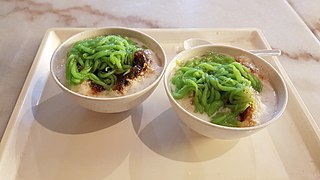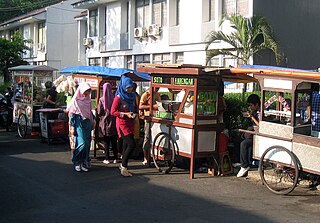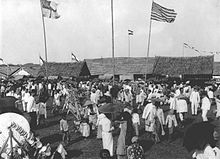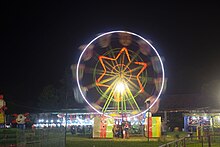
Satay, or sate in Indonesia, is a Javanese dish of seasoned, skewered and grilled meat, served with a sauce. Satay originated in Java, but has spread throughout Indonesia, into Southeast Asia, Europe, America, and beyond.

A kopitiam or kopi tiam is a type of coffee shop mostly found in parts of Indonesia, Malaysia, Singapore, Brunei and Southern Thailand patronised for meals and beverages, and traditionally operated by the Chinese communities of these countries. The word kopi is an Indonesian and Malay term for coffee and tiam is the Hokkien/Hakka term for shop. Traditional kopitiam menus typically feature simple offerings: a variety of foods based on egg, toast, kaya, plus coffee, tea, Horlicks and Milo. Modern kopitiams typically feature multiple food stalls that offer a wider range of foods.

Nasi uduk is an Indonesian-style steamed rice cooked in coconut milk dish, especially popular in Betawi cuisine.

Night markets or night bazaars are street markets which operate at night and are generally dedicated to more leisurely strolling, shopping, and eating than more businesslike day markets. The culture of night markets originates from China and have spread globally with overseas Chinese populations. They are typically open-air markets popular in East Asia, Southeast Asia, and Chinatowns in several other regions of the world.

A curry puff, also known as Vegetable/ Veg puff is a snack of South Asian origin. It is a flaky filo pastry filled with of vegetables like potatoes mixed with spicy curry powder, with meat-based versions that contain chicken and potatoes in a fried or baked pastry shell. The consistency of the curry is quite thick to prevent it from oozing out of the snack. Pap or puff reflects the Fujian Chinese dialect 泡 ('pop'), which means 'bubble, blister, puffed'. It contains influences from Indian, Malay and Chinese cuisines and is a very popular snack food.

Cendol is an iced sweet dessert that contains pandan-flavoured green rice flour jelly, coconut milk, and palm sugar syrup. It is popular in the Southeast Asian nations of Indonesia, Malaysia, Brunei, Cambodia, East Timor, Laos, Vietnam, Thailand, Singapore, Philippines, and Myanmar. Next to the green jelly, additional toppings might be added, including diced jackfruit, sweetened red azuki beans, or durian.

Kue are bite-sized snacks or desserts originally from what is now Indonesia but have since spread throughout Southeast Asia. Kue is a fairly broad term in Indonesian to describe a wide variety of snacks including cakes, cookies, fritters, pies, scones, and patisserie. Kue are made from a variety of ingredients in various forms; some are steamed, fried or baked. They are popular snacks in Indonesia, which has the largest variety of kue. Because of the countries' historical colonial ties, Koeé (kue) is also popular in the Netherlands.

Pasar pagi is a type of traditional market found in Indonesia and Malaysia, sometimes classified as a wet market.

Senen is a long-established urban district of Central Jakarta, Indonesia that has kept many tourist attractions such as two museums, the National Library of Indonesia, Gelanggang Remaja Senen, and narrow alleys with old Chinese and similar style shops and restaurants. It was first developed in the 18th century as Pasar Senen when Governor Daendels established the bovenstad as the new center of government of the fledgling city. Its core remains in what is now the lower-division Senen District, Kwitang, Kenari, Paseban, Kramat, and Bungur. Senen is bounded by a railway line to the east, Ciliwung River to the west, Pramuka Street to the south, and Abdul Rahman Saleh-Kwini II-Senen Raya IV Street to the north. The name is derived from Pasar Senen,.

Sekaten is a week-long Javanese traditional ceremony, festival, fair and pasar malam commemorating Mawlid, celebrated annually started on 5th day through the 12th day of Mulud month.

The Tong Tong Fair was the largest festival in the world for Indo (European-Indonesian) culture, held annually in the Netherlands. In 2009 it was renamed to 'Tong Tong Fair'. Established in 1959 it was one of the oldest festivals and the fourth largest grand fair in the Netherlands. It was also the annual event with the highest number of paying visitors of the Dutch city of The Hague, having consistently attracted more than 100,000 visitors since 1993.

A banana fritter is a fritter made by deep frying battered banana or plantain in hot cooking oil. It is a common dish across Southeast Asia and South India.

Jakarta Fair is a fair held annually in Jakarta International Expo Kemayoran, Jakarta, Indonesia, in June and July. It features exhibitions, trade promotions, shopping, music performances, various shows, amusement rides and a food festival. Jakarta Fair is part of a series of events to held to celebrate the capital's anniversary, which falls on June 22. The Jakarta Fair sees exhibitors from across the country display a whole range of goods and products ranging from specialty food items to traditional handmade arts and crafts. In addition to the many exhibitors, there is also live entertainment including music, dance and cultural performances.

The Gambir Fair was a fair held in 1906 and yearly from 1921 until 1942 in the Koningsplein, Batavia, Dutch East Indies to celebrate the birthday of Queen Wilhelmina of the Netherlands. After the Japanese occupied the Indies, the fair was no longer held. However, after a failed attempt in 1952, in 1968 it was reinstated as the Jakarta Fair.

Bubur ayam is a chicken congee dish served in Southeast Asia. It is rice congee with shredded chicken meat served with some condiments, such as chopped scallion, crispy fried shallot, celery, tongcay or chai poh, fried soybean, crullers, both salty and sweet soy sauce, and sometimes topped with yellow chicken broth and kerupuk. Unlike many other rice dishes, the dish is not spicy as the sambal or chili paste is often served separately. It is a favourite breakfast food, served by humble travelling vendors, warung, fast food establishments, and five-star hotel restaurants. Travelling bubur ayam vendors frequently pass through residential streets in the morning selling the dish.

Taman Suropati or Suropati Park is a public park located in Menteng, Jakarta, Indonesia. The park is located in the center of Menteng and is the meeting point of three streets: Teuku Umar Street, Diponegoro Street, and Imam Bonjol Street.

Wajik or wajid, also known as pulut manis, is a traditional glutinous sweet made with rice, sugar and coconut milk. It is an Indonesian kue, and a kuih of Brunei, Singapore and Malaysia.

Dodol is a sweet toffee-like sugar palm-based confection commonly found in Southeast Asia and the Indian subcontinent. Originating from the culinary traditions of Indonesia, it is also popular in Malaysia, Singapore, Brunei, the Philippines, Southern India, Sri Lanka, Thailand, and Burma, where it is called mont kalama. It is made from coconut milk, jaggery, and rice flour, and is sticky, thick, and sweet.

Indonesian street food is a collection of ready-to-eat meals, snacks, fruits and drinks sold by hawkers or vendors at warung food stalls or food carts. Street food in Indonesia is a diverse mix of local Indonesian, Chinese, and Dutch influences. Indonesian street food is usually cheap, offers a great variety of food of different tastes, and can be found at every corner of the city.

Kampong Kiarong or commonly known as Kiarong, is a village in Brunei–Muara District, Brunei, as well as a neighbourhood in the country's capital Bandar Seri Begawan. It has an area of 383.43 hectares ; the population was 4,530 in 2016.


























